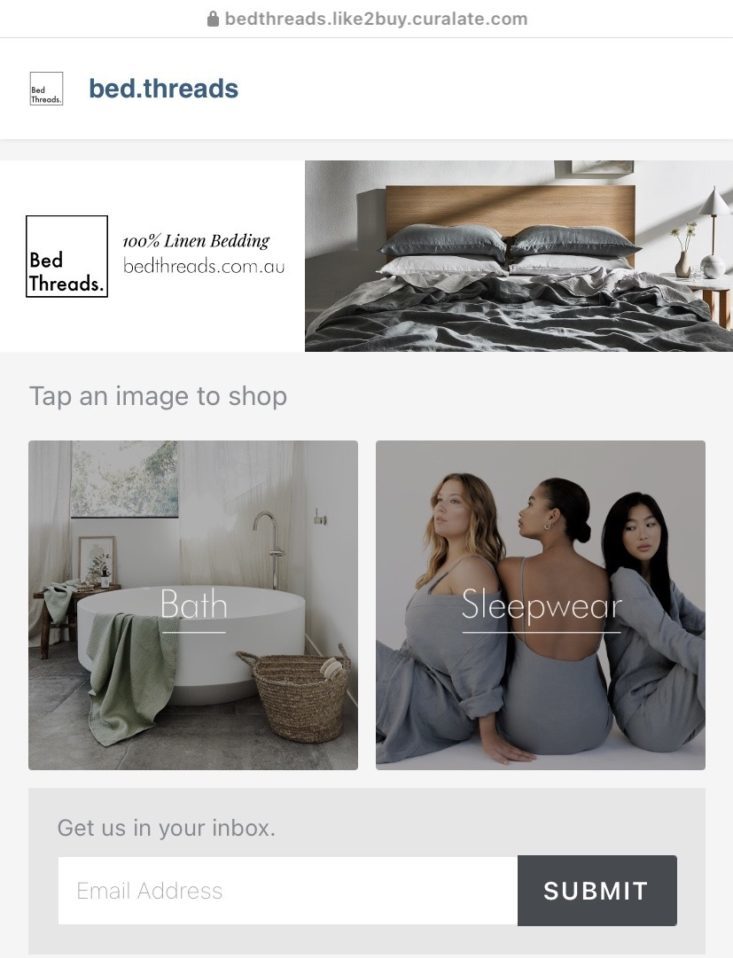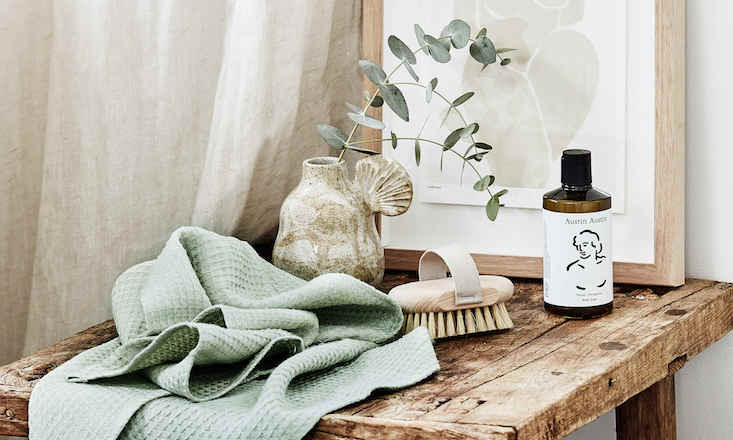
Bed Threads co-founder Genevieve Rosen-Biller. Source: supplied.
Email remains one of the most powerful marketing tools at a brand’s disposal. When working in harmony with other elements of the marketing mix, email can be a potent source of sales; an intimate and personalised conversation with existing and new customers, who want to hear from you.
Crucially, a healthy email database is an owned business asset and arguably more valuable than any social media following, regardless of its size. But it’s also an asset that takes time to build and one that needs constant monitoring and optimising.
Bed Threads co-founder Genevieve Rosen-Biller started building an email database for her luxury bedding and homewares company from the very beginning. Together with her husband and business partner Alan Biller, she spent more than two years developing Bed Threads’ first products and six months out from launch, started capturing the email address of prospective customers. Several hundred people signed up in this time frame and it meant Bed Threads’ first product run sold out in a matter of weeks.
That was in early 2017. In the four years since, Rosen-Biller and her team of 35 have grown the list to more than 300,000.
How? The Bed Threads email marketing strategy draws on Rosen-Biller’s previous experience as a journalist, offering subscribers beautifully presented lifestyle content that wouldn’t be out of place in a leading design magazine, combined with sneak peeks of new product announcements and promotions. The language used is simple and straightforward, and the brand’s popular social media accounts provide an easy entry point for subscribers to sign up.
“Nothing is as direct and as powerful as actually getting inside someone’s inbox,” Rosen-Biller tells SmartCompany Plus.
“It’s a very personal experience; if they open your email, they genuinely want to hear from you.”
Key takeaways
Keep it simple. Use clear calls to action to encourage sign-ups. A few words is all you need.
Don’t pretend you’re something you’re not. Avoid euphemisms or vague promises. If you sell high-quality bedding, tell prospective customers that’s what you sell.
Find a balance between staying in touch and explicitly selling. Mix the sales messages with useful and relevant content.
When you have something exciting to share, go big.
If an email or campaign hasn’t resonated with subscribers, it is rarely because of only one thing. Look at all elements as a whole.
Social media, and Instagram in particular, can be a powerful tool for capturing more email subscribers.
Remember, if someone has signed up to your email list it means they want you to contact them. The relationship has already been established.
Language matters
The concept for Bed Threads was born from Rosen-Biller’s own experience. The goal was to simplify the buying process for shoppers exactly like herself, who were looking for high-quality, beautiful bedding products at a fair price point, which could be purchased as a set, rather than separates. The initial product range of French Flax linen featured bedding sets (a fitted sheet, duvet cover and two pillowcases) in a range of six core colours.

Bed Threads’ signature range features French Flax linen bedding sets. Source: supplied.
The value proposition was simple, so the initial messaging and strategy needed to be too. Rosen-Biller created Bed Threads’ Instagram account in February 2017 and began cultivating a following by sharing images to show customers what they could expect from the brand. The Instagram account featured a link in its bio, which took people to a simple landing page where they could sign up to receive emails from Bed Threads.
With limited characters to work with on the Instagram bio, the calls to action both there and on the Bed Threads website landing page were to the point. Customers were told, “the best sleep of your life is on the way” and more specifically, they could buy “pure 100% French Flax linen packaged in a set, delivered to your door for free”.
“It wasn’t shrouded in secrecy what we were doing; we were trying to communicate that we were doing bedding and that it was limited, and that we would be different,” explains Rosen-Biller.
It was important to convey the ease of the buying experience, says Rosen-Biller, as bedding had traditionally been a category that was not user-friendly and which contained confusing product names.
“It was just all really clunky and inconvenient when you’re actually talking about something that’s really simple,” says Rosen-Biller.
Turbo-charge with Instagram
The Bed Threads range now includes 22 bedding colours, which can be mixed and matched, along with sleepwear, homewares and tableware. But the communication strategy of keeping things simple remains, as does the integration between the online retailer’s Instagram account and its email sign-ups.
Bed Threads uses a tool called Curalate, which allows it to both schedule Instagram posts and direct those visiting its Instagram bio to multiple pages on its website, whether that’s a particular product page or article from its Journal content section. There is also the option to simply subscribe via a box labelled “Get us in your inbox”.

What Instagram users see when they click the link in Bed Threads’ bio. Source: Instagram
Instagram has become one of the brand’s most significant channels, growing from a following of 100,000 in March 2020 to now over 290,000 followers.
“Think about Instagram as your shop … that’s how people prefer to shop now, [they] do it in their own time and when it’s convenient for them,” Rosen-Biller advises.
“In the same way that when you go into a store there’s usually something that they do to try and incentivise you to join their mailing list or shopping club, I think this is the modern version of that”.
By its very visual nature, Instagram is all about building an emotional connection with people. So, Rosen-Biller says, if someone is subscribing to your emails because they like one of your Instagram images, “that’s already quite a high level of engagement”.
To send or not to send
Once you have people willing to receive your brand’s emails, the next logical questions to answer are: what do you send them, and how often?
Bed Threads sends two to four emails to its subscribers a week, usually at night, and posts multiple times a day on Instagram, both on the grid and in Stories. The content of the emails varies — it could be a recipe from a guest chef, or a first look at an upcoming product release. Promotional offers are also thrown into the mix, as are spotlights on particular colour trends or seasonal styling ideas.
Increasingly, the brand is segmenting out its customer base and delivering tailored content to those segments. If someone has purchased tableware, for example, they will receive the recipe content.

Bed Threads shares beautifully presented lifestyle content. Source: supplied.
Whereas once Rosen-Biller was managing all of the brand’s marketing and communications herself, she now has a content and marketing team helping her fine-tune each email send. They analyse every element of the emails, usually three to four days after sending, considering everything from the subject line and opening line of text, to the images used and the order of content presented. It’s a “constant work in progress” finding the most effective combination, says Rosen-Biller.
While the winning formula may be at times elusive, the Bed Threads team sticks to a hard rule of avoiding constant sales messaging. The last thing you want to do is bombard your subscribers, she says.
It’s about really understanding what’s in it for the end user, and for Bed Threads, that means a content-first approach.
“I think we all receive emails from multiple brands every day with sales messaging and realistically, people aren’t shopping every single day at the same place. Even if you’re buying from multiple retailers multiple times a week, it’s unlikely you’re buying from the same retailer every week. So I think just be mindful of what you’re putting out and what is actually in it for the person on their lunch break or on their commute.”
On the flip side, when you have something exciting to share, don’t hold back, says Rosen-Biller.
“If you do have a new product launch that you’ve worked hard on that’s innovative and exciting, you should send an email because your customers will want to know about that and it’s exciting to them too,” she says.

The Bed Threads range has grown to include bath products, as well as homewares and sleepwear. Source: supplied.
Big picture thinking
Building an effective marketing strategy is about taking the individual parts of the marketing mix, like email, and finding a way for them to talk to each other. It makes sense then, as Rosen-Biller explains, that when a campaign misses the mark, it is never just one thing that has gone wrong.
“You can’t ever overstate one platform over the other,” she says.
“If we have a good day or a successful campaign, or people really seem to like a new launch or a new campaign or whatever it might be, it’s because we have, firstly, a really smooth strategy that has come to fruition on all different platforms.
“Your Google ads won’t work if no one sees you on social media and you don’t capture their attention there, and conversely, your emails are not going to work if you don’t have a presence in other places where you’re talking to people at the relevant time.”
It works in reverse too. A really great subject line in your email can push everything else up on those other channels, says Rosen-Biller. The point is to develop an overall strategy and then customise your content to make sense in each of these different spaces.
“People are in a very different mind frame when they’re on Pinterest, versus when they’re reading emails, versus when they see a Facebook ad or an Instagram ad,” Rosen-Biller says.


COMMENTS
SmartCompany is committed to hosting lively discussions. Help us keep the conversation useful, interesting and welcoming. We aim to publish comments quickly in the interest of promoting robust conversation, but we’re a small team and we deploy filters to protect against legal risk. Occasionally your comment may be held up while it is being reviewed, but we’re working as fast as we can to keep the conversation rolling.
The SmartCompany comment section is members-only content. Please subscribe to leave a comment.
The SmartCompany comment section is members-only content. Please login to leave a comment.